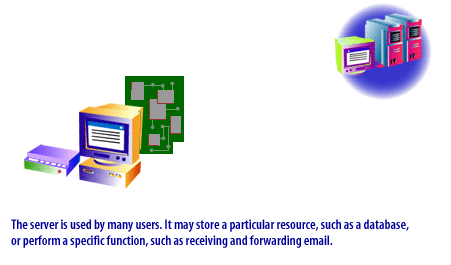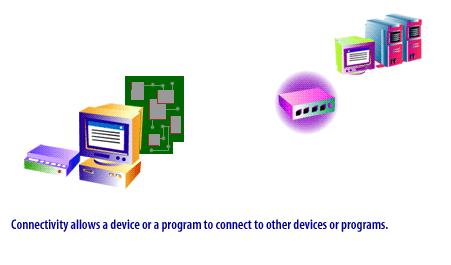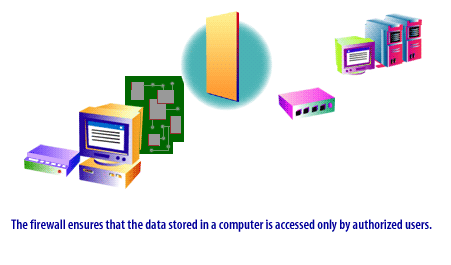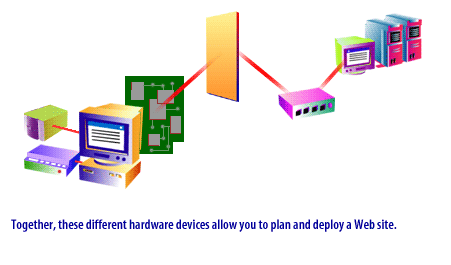| Lesson 2 | Hardware types and functions |
| Objective | Describe the three hardware categories required for planning a Web site. |
Hardware Types and Functions
Here are the three crucial hardware categories for an e-commerce vendor, along with why they matter:
- Servers
- Why They're Important: Servers are the backbone of your e-commerce operation. They house your website, store product information, and process customer data. Reliable servers are essential for fast page loads, handling a high volume of transactions, and securing sensitive information.
- Types to Consider:
- On-Premise Servers: You own and manage the hardware physically located on your own site. This offers maximum control, but also comes with higher upfront costs and maintenance responsibilities.
- Cloud Servers: You rent server space from cloud providers like Amazon Web Services (AWS), Google Cloud Platform (GCP), or Microsoft Azure. This provides scalability, flexibility, and often lower costs since you're only paying for what you use.
- Client Devices:
- Why They're Important: Your customers use client devices (computers, laptops, tablets, smartphones) to access your store. Optimizing your e-commerce site for these devices directly impacts the shopping experience, conversion rates, and customer satisfaction.
- Types to Consider:
- Desktops/Laptops: Ensure your website functions smoothly on various screen sizes and browsers.
- Mobile Devices: Mobile responsiveness is paramount. A growing number of people shop on their phones, so the layout, buttons, and checkout process must adapt seamlessly to smaller screens.
- Networking Equipment
- Why It's Important: Robust networking equipment creates a reliable connection between your servers, devices, and the wider internet. A strong network ensures fast delivery of data, prevents downtime, and protects against security breaches.
- Types to Consider:
- Routers and Switches: These direct data traffic flow within your network and to the internet.
- Firewalls: These act as a line of defense, filtering network traffic and blocking potential threats.
- Load Balancers: These distribute incoming traffic across multiple servers, preventing overload and slowdowns during high traffic periods.
- Storage: You'll need sufficient storage for product images, videos, customer data, and order information. Consider hard drives, external storage solutions, or cloud storage options.
- Barcode Scanners/Printers: If you manage a physical inventory, you'll need barcode scanners for efficient inventory tracking and printers for shipping labels.
- Point of Sale (POS) Systems: If you have a brick-and-mortar component to your business, POS systems will handle in-person transactions and keep your inventory synchronized with your online store.
The success or failure of a Web site depends on numerous factors, including the ability of the site's hardware to meet the needs of the site and its users. In most cases, a Web site development team is not directly involved in the selection of hardware; generally the client has already done so. However, whenever possible, the Web team (particularly the Technical team) needs to understand any potential limitations or restrictions that the hardware may impose on the site's functionality.
Hardware types and functions
Hardware needs can be divided into three categories based on their type and function: client, server, and connectivity/security needs. In addition, a network should include a hardware device that ensures uninterrupted power.
- Client hardware: The typical client hardware consists of a desktop computer, a network interface card (NIC), and a modem or other client-side connectivity device. A desktop computer usually consists of a CPU, hard drive, and monitor. It runs programs as well as other software used to request information from the server. Client hardware may also include Internet-enabled devices such as Palm Pilots or other hand-held devices.
- Server hardware: A server is typically a remote device (CPU, hard drive, and various programs) shared by many users. A server may be a machine that stores a particular resource, such as a database or Web pages, or a machine that performs specific functions, such as forwarding and receiving email.
- Connectivity and Security Hardware: Connectivity hardware allows a program or device to link with other programs and devices. Security hardware ensures that data stored in a computer cannot be accessed by unauthorized users. You will learn about the different types of connectivity and security devices later in this module.
Uninterrupted Power Supply (UPS)
An uninterrupted power supply (UPS) is any hardware device ensuring that electrical power continues to be available to computers and other network devices during a power outage or other interruption in power. UPS devices include battery systems, internal combustion motors (or engines) that run AC generators, and rotary devices that use a large flywheel to offer power during brief outages. The following series of images illustrates a step-by-step process of integrating hardware into a network design plan:






Customer Experience Strategy
Hardware Requirements for a Website
The hardware requirements for a website depend on various factors, such as the type of website, the expected traffic volume, and the complexity of the website's application. However, some basic hardware requirements that apply to most websites are:
The hardware requirements for a website depend on the website's needs and expected traffic volume. Websites require a server, storage space, bandwidth, backup and recovery, security, power and cooling, and redundancy to ensure reliable and secure operation. On small instances, server load is primarily driven by peak visitors. For five concurrent Users:
In the next lesson, you will learn about the types of servers and their functions.
- Server: A web server is the primary hardware requirement for hosting a website. The server can be a physical server or a virtual server, depending on the website's needs. The server must have enough processing power, memory, and storage space to handle the website's traffic and application requirements.
- Storage: Websites require storage space to store web content, such as images, videos, and other multimedia files. The amount of storage required will depend on the size of the website and the type of content being stored.
- Bandwidth: Bandwidth is the amount of data that can be transferred between the server and the users. Websites with high traffic volume or that handle large amounts of multimedia content will require more bandwidth to ensure fast and reliable access.
- Backup and recovery: It is essential to have a backup and recovery system in place to ensure that website data is protected and can be recovered in case of a hardware failure or other disaster.
- Security: Hardware requirements for website security include firewalls, intrusion detection systems, and SSL certificates to ensure that website data is protected against unauthorized access and hacking attempts.
- Power and cooling: The hardware must be installed in a climate-controlled room or data center with adequate power and cooling to ensure that the server operates reliably.
- Redundancy: To ensure maximum uptime and prevent data loss, it is important to have redundant hardware, such as servers, storage devices, and network equipment, in place.
The hardware requirements for a website depend on the website's needs and expected traffic volume. Websites require a server, storage space, bandwidth, backup and recovery, security, power and cooling, and redundancy to ensure reliable and secure operation. On small instances, server load is primarily driven by peak visitors. For five concurrent Users:
- 1GHz+ CPU
- 512MB RAM
- 20MB database space
- 300MB disk space
- 25 Concurrent Users
- Dual 2GHz+ CPU
- 2GB+ RAM
- 80MB database space
- 1GB disk space
In the next lesson, you will learn about the types of servers and their functions.